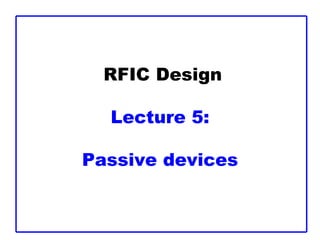This document discusses passive devices used in RFIC design, including inductors, capacitors, and resistors. It covers topics like:
- Different types of inductors and their modeling approaches. Enhancing inductor Q factors by reducing metal and substrate losses.
- Varactors/tunable capacitors using junctions and accumulation modes. Their Q factors and tuning ranges as a function of bias.
- RC and RLC networks, including their impedance transformations between series and parallel configurations. Definitions of Q factor for different passive components and networks.







































































